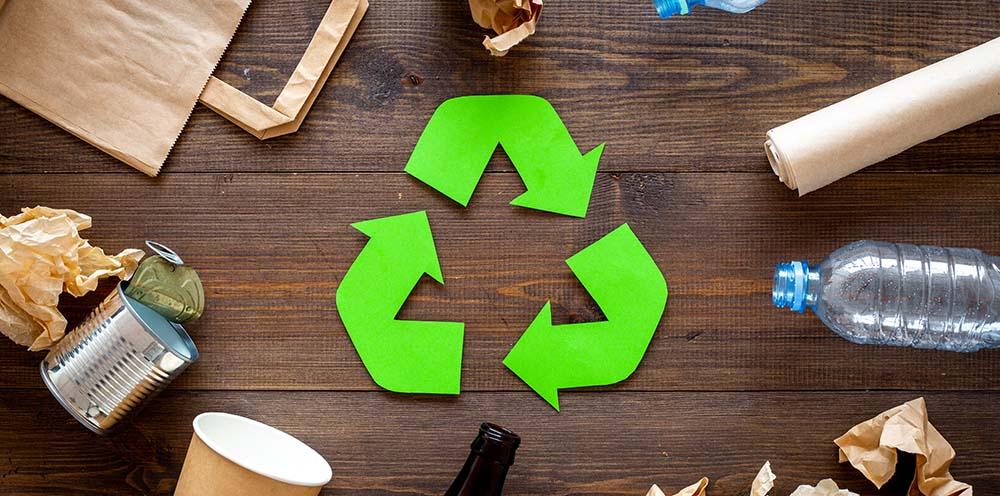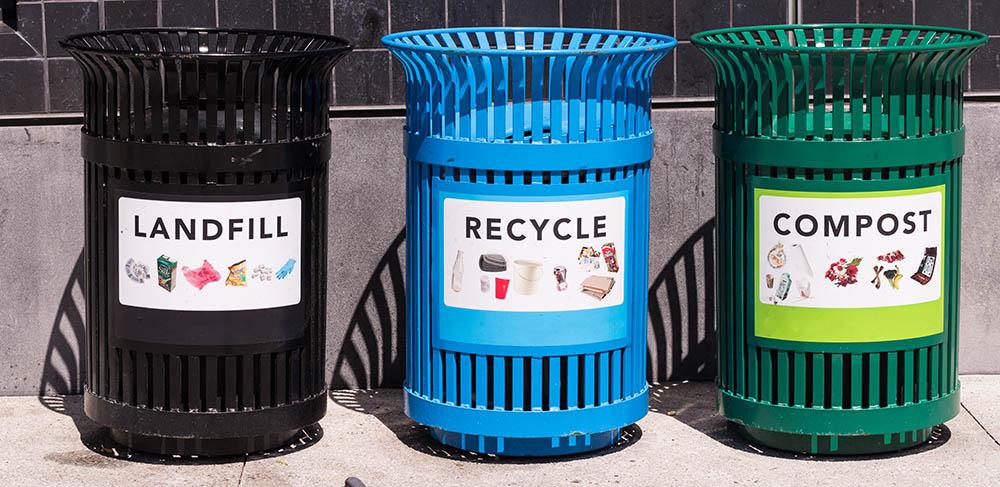In this article, we'll cover:
- What is composting?
- What is recycling?
- How much trash is actually composted or recycled?
- What are the benefits of recycling versus composting?
- Can you recycle compostable products?
- What happens if I can't compost compostable products?
- What items can be recycled, composted, or sent to a landfill?
- What are alternative downstream used for products?
What is Composting?
Many of us grew up hearing, “Reduce, Reuse, and Recycle.” And two additional Rs have been added to the mix: “Refuse” and “Rot.” It’s not always possible to “refuse,” but more people are becoming comfortable with the idea of “rotting” our waste. This is where composting comes in.
Composting entails transforming organic waste like yard scraps, food scraps, and plant-based compostable packaging into compost. Compost is nutrient-rich decayed organic matter, a perfect soil amendment, and garden fertilizer. The process requires moist, hot, aerobic conditions to destroy pathogens and concentrate nutrients.
Composting can occur in a home compost pile with a balance of nitrogen-rich green and carbon-rich brown waste. Alternatively, food scraps and organic materials can be broken down in controlled conditions in a commercial composting facility. Fortunately, there are a growing number of commercial and residential compost collection programs and facilities. Learn more about the differences between home and commercial composting in our guide.

What is Recycling?
Recycling, on the other hand, is the process of breaking down plastic, paper, metal, and glass from their original forms into raw materials. Items are collected, sorted, cleaned, melted, and sold as recycled raw materials. Eventually, they become new products, like aluminum cans, plastic bottles, newspapers, and, increasingly, products like carpet, insulation, shoes, and clothes. But, beware, there are many products that you think you can recycle but can't.
How Much Trash is Actually Composted or Recycled?
Everything we dispose of needs to go somewhere. There are four general options: a landfill, incinerator, a materials recovery facility (MRF) for recycling, or an industrial or home composting system. We want to avoid landfills and incinerators as much as possible due to the toxins they emit.
According to the Environmental Protection Agency (EPA), 292.4 million tons of solid waste are generated annually and they estimate that 75% of the US waste stream is recyclable or compostable. But how much waste actually gets composted or recycled?
292.4 million tons of solid waste are generated annually and it's estimated that 75% of the US waste stream is recyclable or compostable.
The answer is around 94 million tons. This breaks down into 25 million tons being composted, with the remaining 69 million tons being recycled. That means almost 185 million tons of solid waste ends up in a landfill or incinerator.
The good news is that composting and recycling rates have increased in recent decades. Before 1990, composting was rarely used to process waste. Also, the recycling rate has increased from less than 7% in 1960 to the current rate of 32%. While consumer accessibility and education around composting and recycling needs improvement, including confusion over recycling symbols, the EPA recognizes their importance.

What Are the Benefits of Recycling versus Composting?
There are clear benefits to both recycling and composting. When we recycle, we save energy, conserve resources, curb pollution, minimize the need for new raw materials, and create jobs.
It is important to note that most recyclable products are actually “downcycled,” or turned into lower-quality materials. A plastic bottle may become carpeting or filling for winter coats, for example. At some point, the material is of such low quality that it can no longer be recycled. In most cases, plastic can only be recycled once or twice before it ends up in a landfill.
There are also many environmental benefits of composting too. When we compost we also save energy, conserve natural resources, curb pollution, increase domestic security and create jobs. In addition, composting helps to reduce the need for fossil fuel-based chemical fertilizers. It also supports the production of beneficial bacteria and fungi and reduces methane emissions associated with landfills.
Most importantly, composting helps to enrich the soil, which is critical as much of Earth’s land is degraded. Fertile soil is being lost at a rate of 24 billion tonnes a year. By retaining moisture and nutrients, composting can have a long-term impact on maintaining arable soil and supporting the food web.
It’s hard to say one is better than the other because composting and recycling apply to different types of products. Because of recycling's limitations, recycling symbol confusion, and energy requirements of the recycling process, composting is generally considered a greener option.

Can you recycle compostable products?
Compostable products and recyclable products are designed for different waste management processes, so it's important to handle them appropriately.
Compostable Products are designed to break down into natural elements through composting. They are typically made from organic materials like plant fibers or bio-plastics. Compostable products should be placed in compost bins or taken to industrial composting facilities where they can decompose properly.
Recyclable products, on the other hand, are made from materials like glass, metal, paper, and certain plastics that can be processed and made into new products. Recyclable products should be cleaned and placed in recycling bins.
If compostable products end up in a recycling container, they can contaminate the recycling stream. Recycling contamination occurs when non-recyclable materials (like this surprising list of products) are placed in recycling bins or when recyclable materials are not properly cleaned or sorted. This contamination can significantly disrupt the recycling process and reduce the quality of recycled materials. Depending on the level of contaminant, batches may even be rejected by recycling facilitates and sent to landfill or incinerators instead, defeating the purpose of recycling efforts.
Most compostable packaging should be composted versus recycled with the exception of recyclable paper products like paper bags, coffee cup sleeves and paper clamshell produce containers. These items are both 100% recyclable and compostable but should be recycled first if possible in order to reuse the material.
In summary, you should not put compostable products in with recyclables. Instead, dispose of them in a composting system to ensure they decompose correctly and contribute to soil health. Always check local guidelines for composting and recycling, as facilities and accepted materials can vary by region.

What happens if I can't compost compostable products?
Even if you can't compost certain products like compostable food and drink packaging, there are still many benefits in choosing these options over petroleum-based containers. For example, they are made from renewable materials, their production doesn't involve toxic chemicals, and they generally use fewer resources to manufacture versus their plastic and foam counterparts. Also, should compostable products end up in a landfill, they will break down into organic plant-based materials versus microplastics that leech harmful chemicals.
Items that Can be Recycled, Composted, or Sent to Landfill
So how do you know what’s compostable vs. recyclable vs. landfill?
Items that can be recycled:
According to the EPA, these are some of the most commonly recycled items:
- Glass Bottles & Jars
- Plastic Bottles & Caps
- Cardboard & Paperboard Boxes
- Newspaper & Paper Scraps
- Aluminum Cans & Tin Cans
Items that can be composted:
Again, the EPA has made it easy to determine what products can be composted:
- Fruits & Vegetables
- Coffee Grounds & Filters
- Eggshells & Nutshells
- Cardboard & Paper
- Grass Clippings & Yard waste
- Hay & Straw
- Sawdust & Wood chips
- Cotton & Wool Rags
Compostable food packaging can also be sent to commercial composting facilities. In some cases, they may be home compostable.
Items that should be sent to landfill:
These are some of the items that can’t be recycled or composted and should be thrown away:
- Pet Waste
- Food-Soiled Paper Products (Greasy Pizza Boxes)
- Non-recyclable Plastics (Bags, Films, Wrappers)
- Paper or Metal items mixed with plastic
- Polystyrene (Foam Cups & Packaging)
- Textiles & Toys (if they can’t be recycled)

Alternative Downstream Uses for Products
Let’s go back to those five Rs: Refuse, Reduce, Reuse, Recycle, and Rot.
We’re starting to see “Refuse” and “Reuse” become popular in mainstream culture. Due to car-sharing apps and local programs to rent tools and equipment, saying “no” to purchasing products is becoming easier.
Gaining even more momentum are programs that allow us to reuse goods, reducing the amount of new manufacturing. Driven by Generation Z, the resale movement is on an upward trajectory. Trends and social media have made thrifting clothes and accessories cool, sustainable, and affordable. With data suggesting that it will eclipse fast fashion by 2029, thrifting has already become a $28 billion industry.
Final Thoughts on Composting versus Recycling
The popularity of reusing items is a good sign, as are nationwide increases in commercial composting facilities. As awareness of the impact of our consumption grows, so do approaches to limit contributions to landfills and incinerators.
More people are recognizing the environmental impact of using compostable materials instead of plastic and problem materials. Instead of focusing on the composting bin vs. recycling bin, we should instead limit the amount of waste we're producing.



